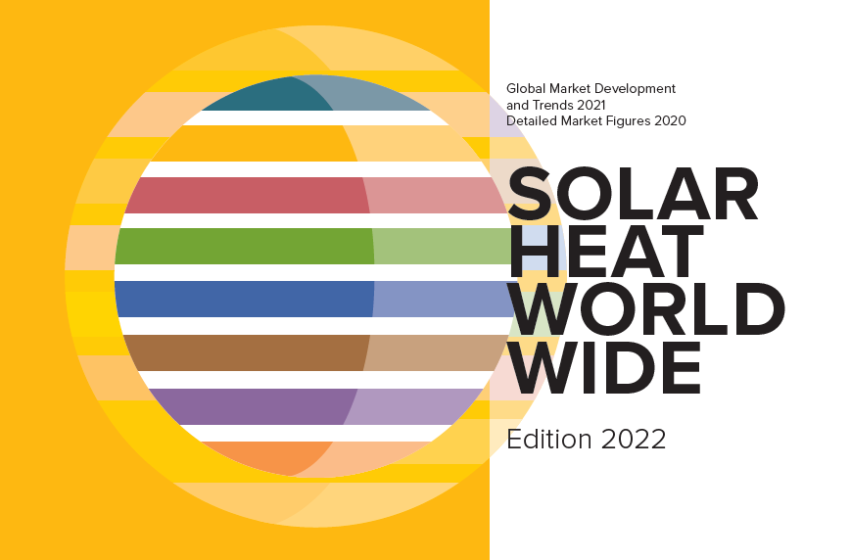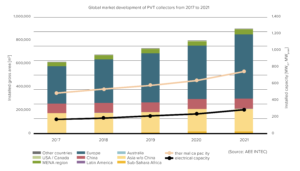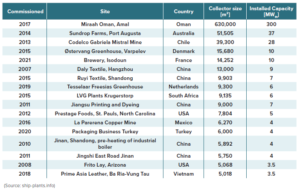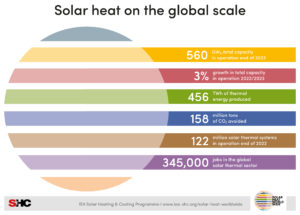Solar Heat Worldwide: launch of IEA SHC flagship publication
June 24, 2022
The global solar thermal market saw 3 % growth in 2021 after seven years of decline. Noteworthy development was reported from some of the largest solar heat markets such as Brazíl, United States, Greece and Italy. Solar thermal capacity in operation reached 522 GWth, providing green heat to 109 million residential and commercial customers globally. With a turnover of USD 18.7 billion, the sector gives jobs to around 380,000 people worldwide. These are some key figures from this year’s report, Solar Heat Worldwide 2022, published by the IEA Solar Heating and Cooling Program. The 18th edition has a completely new design. Data from now 70 country contributors creates the most comprehensive evaluation of solar heating and cooling markets worldwide. The full report and key findings are available for free on the IEA SHC website (www.iea-shc.org/solar-heat-worldwide).
“With 21 GW of new capacity installed in 2021, the solar thermal sector has again proven that it is a significant player in the move towards climate neutrality. Our flagship publication Solar Heat Worldwide shows the wide range of customers that can profit from zero-carbon heat produced onsite,” states Tomas Olejniczak, Chair of the IEA SHC Programme.
Support policies and rising fossil fuel prices drive demand
Positive trends were observed in several large solar heat markets. Italy, for example, experienced a phenomenal 83% growth last year, driven by increased construction activities combined with a new tax reduction scheme, the Superbonus for energy-efficient buildings. Likewise, demand in Brazil (+29 %) and the United States (+19 %) rose as people spent more time at home during the pandemic and invested in solar pool heating solutions. Sales for commercial clients in Brazil also increased due to growth in the construction sector and rising electricity prices caused by power shortages.

Solar heat markets with the highest growth rates in 2021. Source: Solar Heat Worldwide 2022
PV-Thermal market on the rise
A highlight of this year’s report is the comprehensive chapter on PV-Thermal systems (PVT) – generating both solar heat and solar electricity. Thirty-eight manufacturers around the world provided detailed sales data giving a country-specific view on PVT deployment. France is the leading market with air-based PVT collectors used for heating. However, unglazed PVT collectors gained popularity as a heat source for brine heat pumps in residential and commercial buildings in the other leading countries, South Korea and China.
Today, 1.4 million m2 of PVT collector area is in operation. In 2021, the global PVT capacity in operation grew 13 % after steady 9 % growth between 2017 and 2020.

Cumulated PVT capacity for the years 2007 to 2021. Source: Solar Heat Worldwide
Multi-MW solar industrial heat plants around the world
Industrial companies around the world increasingly ask for a CO2-free heat supply. The largest solar industrial heat (SHIP) plants are listed in the report with a 300 MW plant in an oil field in Oman, followed by a 37 MW system in Australia for a tomato producer and a 28 MW system for a copper mine in Chile (see table below).

Solar Heat for Industrial Processes plants with more than 5,000 m² Source: Solar Heat Worldwide 2022
Most comprehensive evaluation of solar heating markets worldwide
First published in 2005, this year’s Solar Heat Worldwide provides market data on installed capacities and share of applications from 70 countries. The 85-page report includes a special focus on China, the world’s largest solar thermal market. Solar Heat Worldwide has a solid reputation as a reference source for solar heating and cooling data among international organizations, including REN21 and IRENA. The report was again the main contributor to the solar heating and cooling chapters of REN21’s Renewable 2022 Global Status Report (GSR), one of the key policy adviser reports on renewables. Solar Heat Worldwide was again written by Werner Weiss and Monika Spörk-Dür from the Austrian research institute AEE INTEC and supported by the Federal Ministry for Climate Action of the Republic of Austria and solar heat experts worldwide.
More information:


